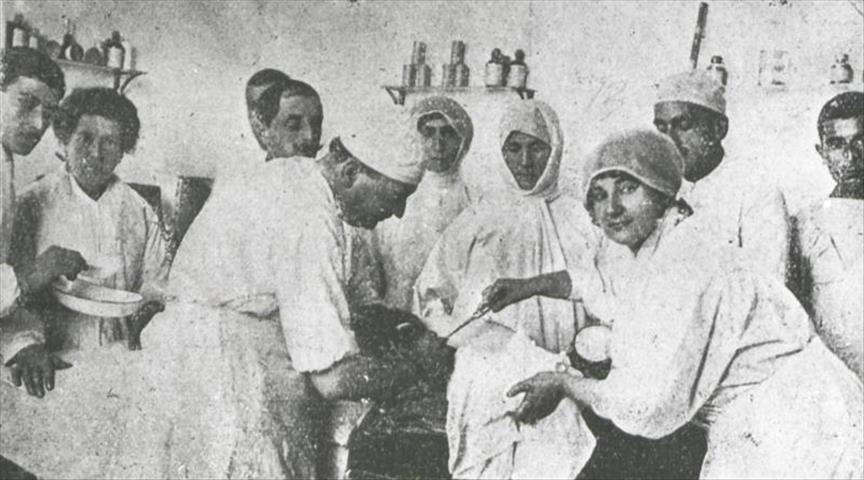
By Burcu Arik
ISTANBUL
A veteran of four wars now fallen on hard times… a 19th century hospital in the western Turkish province of Canakkale has seen devastating conflict as well as being a sanctuary for thousands of dying and wounded soldiers, both friend and foe.
Now the ruined Ottoman-era facility could be at the center of a new restoration bid.
"Located on a slope dominated by a sea view, Canakkale Old Central Hospital (Kale-i Sultaniye Hastahane-i Askeriyye in Ottoman) has been an eyewitness to history since the 1890s in spite of being half-ruined today…"
So says architect Senem Yigit Kahraman, writing in the Turkish Yearbook of Canakkale Studies.
A restorations expert at Istanbul Technical University, Kahraman says the hospital was originally built as a military institution, with a 1,000-person capacity: "It was also aimed at increasing the number of personnel and doctors in the region due to the wars at that time."
Having been strengthened during the 1911 Turkish-Italian Tripoli War and 1912-13 Balkan War, the hospital served as a central medical facility for mobile army health units in 1914-15 during the Gallipoli [Gelibolu] Campaign and World War I.
"It was also used as a 'Seriously Wounded' Hospital' by 1916. It received many injured people, treated the dying and dealt with the death toll," Kahraman says.
The aforementioned years saw a global war centered in Europe that began in 1914.
By the time the war ended, more than four years later, 10 million people would be dead. The 19th century would be truly over and the 20th century – the bloodiest in human history – truly begun.
But the Gallipoli Campaign had a quite different aspect for the Turkish side compared to WWI, as it moved from war to victory and tragedy before becoming an epic.
The victory against the Allies in the Dardanelles (Canakkale) Strait gave Turkey a massive moral boost that enabled it to wage a war of independence and eventually, in 1923, form a republic from the ashes of the Ottoman Empire.
However, the cost was that tens of thousands of Turkish nationals and soldiers died, along with tens of thousands of Europeans, plus around 7,000-8,000 Australians and nearly 3,000 New Zealanders.
Nurhan Aydin, an academic in Kafkas University, writes in an article called "The Sanitary Matters and Evacuation Services in the Canakkale Wars" that soldiers living in trenches tried to survive amid stagnant water and inadequate sanitation.
"Conditions were harsh, the area possessed no natural water source and the soldiers were also filled with disease," Aydin says, adding that the wait for treatment and evacuation was often long and agonizing.
During the major clashes, the number of the wounded sometimes exceeded 4,000 people per day."
Kahraman says Canakkale Old Central Hospital played an significant role in the treatment and discharge process of soldier in wartime.
According to the Turkish Medical Department, Canakkale hospitals, including the Old Central Hospital, hosted more than 110,000 wounded and 70,000 sick people in just a few months during the Gallipoli Campaign.
However, today most of the Ottoman-period hospitals are in a ruinous state, with the Old Central Hospital taking some of the worst punishment. According to Kahraman: "The hospital received the most damage during the Gallipoli Campaign. It was bombed during the war, over and over again.”
“British forces bombed it twice on the same day despite displaying all the warning signs showing it was a hospital," she claims.
Although being damaged by bombings, the hospital did not stop operating until the Armistice of Mudros in October 1918, when the Allies invaded Anatolia, demilitarized Canakkale and closed the facility.
"The destructive effect of the bomb is still visible at the site. The north and west wings have collapsed... Only a fraction of the 75-centimeter-thick masonry walls from the hospital remain today," Kahraman says.
According to the Turkish Yearbook of Canakkale Studies, the western wing was bombed by British planes during WWI. Approximately 90 percent of walls of the northern and western blocks were demolished.
There are small pieces surviving from the timber roof which covered the building, which has endured decades of neglect.
"Therefore, the stone elements and mortar of the walls have been also exposed to fires and earthquakes over the years as well as freezing-and-thawing cycles, snow, rain water and wind," Kahraman writes.
Now Istanbul Technical University is offering some project ideas to preserve and protect the remaining parts of the hospital that played a meaningful role in the past.
Within the scope of the restoration project, which wants future generations to be able to discover the past, the protection and strengthening of the existing ruins is the most prioritized topic, says Kahraman.
The restoration project proposes that the east and south wings of the building be reconstructed and the west and north wings be used as an open-air museum.
"With the restoration, it will continue to serve humanity and history as it did in the past," Kahraman adds.
Anadolu Agency website contains only a portion of the news stories offered to subscribers in the AA News Broadcasting System (HAS), and in summarized form. Please contact us for subscription options.

